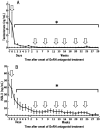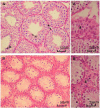Inhibitory effects of long-term repeated treatments of a sustainable GnRH antagonist, degarelix acetate, on caprine testicular functions
- PMID: 32830151
- PMCID: PMC7768175
- DOI: 10.1262/jrd.2020-035
Inhibitory effects of long-term repeated treatments of a sustainable GnRH antagonist, degarelix acetate, on caprine testicular functions
Abstract
We investigated the effects of long-term repeated treatments with a sustainable gonadotropin-releasing hormone (GnRH) antagonist, degarelix acetate, on testicular hormonal secretion, size, ultrasound images, histology and spermatogenesis in goats to assess its efficacy as a chemical castration method. Male Shiba goats (3-6 months of age) were treated subcutaneously with degarelix acetate every 4 weeks for 24 weeks. Plasma testosterone and insulin-like peptide 3 concentrations decreased (P < 0.05) within 2 days after the first treatment and remained low until 29 weeks (P < 0.05). Scrotal circumference and testicular pixel intensity were lower from 2-6 months and from 1-6 months, respectively, compared to the pretreatment values (P < 0.05). The testis and epididymis weights were lower at 24 weeks compared to those in untreated goats (P < 0.05). There were no sperm in the seminiferous tubules of testicular tissue sections or in homogenates of the epididymis at 24 weeks. These results suggest that repeated treatment with degarelix acetate is an effective chemical castration method for goats.
Keywords: Chemical castration; Male goat; Sperm; Sustainable GnRH antagonist; Testicular hormones.
Figures




Similar articles
-
The GnRH Antagonist Degarelix Suppresses Gonadotropin Secretion and Pituitary Sensitivity in Midgestation Sheep Fetuses.Endocrinology. 2022 Feb 1;163(2):bqab262. doi: 10.1210/endocr/bqab262. Endocrinology. 2022. PMID: 34958103 Free PMC article.
-
Effects of long-acting GnRH antagonist, degarelix acetate, on plasma insulin-like peptide 3, testosterone and luteinizing hormone concentrations, and scrotal circumference in male goats.Theriogenology. 2017 Jan 15;88:228-235. doi: 10.1016/j.theriogenology.2016.09.032. Epub 2016 Sep 21. Theriogenology. 2017. PMID: 27793455
-
Reversible inhibition of testicular function by a gonadotropin hormone-releasing hormone antagonist in monkeys (Macaca fascicularis).Fertil Steril. 1984 Dec;42(6):906-14. doi: 10.1016/s0015-0282(16)48264-6. Fertil Steril. 1984. PMID: 6389185
-
Degarelix. More rapid medical castration, nothing more.Prescrire Int. 2010 Jun;19(107):106-8. Prescrire Int. 2010. PMID: 20738032 Review.
-
Degarelix: a gonadotropin-releasing hormone antagonist for the management of prostate cancer.Clin Ther. 2009;31 Pt 2:2312-31. doi: 10.1016/j.clinthera.2009.11.009. Clin Ther. 2009. PMID: 20110043 Review.
Cited by
-
The GnRH Antagonist Degarelix Suppresses Gonadotropin Secretion and Pituitary Sensitivity in Midgestation Sheep Fetuses.Endocrinology. 2022 Feb 1;163(2):bqab262. doi: 10.1210/endocr/bqab262. Endocrinology. 2022. PMID: 34958103 Free PMC article.
-
Insulin-like peptide 3 in domestic animals with normal and abnormal reproductive functions, in comparison to rodents and humans.Reprod Med Biol. 2022 Sep 22;21(1):e12485. doi: 10.1002/rmb2.12485. eCollection 2022 Jan-Dec. Reprod Med Biol. 2022. PMID: 36310659 Free PMC article. Review.
References
-
- Tamada H. Contraception. In: Nakao T, Tsumagari S, Katagiri S (eds), Theriogenology 4th ed, Tokyo: Buneido Publishing Company; 2012: 275–281 (In Japanese).
-
- Cronin GM, Dunshea FR, Butler KL, McCauley I, Barnett JL, Hemsworth PH. The effects of immmuno- and surgical-castration on the behavior and consequently growth of group-housed, male finisher pigs. Am Behav Sci 2003; 81: 111–126.
-
- Marti S, Jackson JA, Slootmans N, Lopez E, Hodge A, Pérez-Juan M, Devant M, Amatayakul-Chantler S. Effects on performance and meat quality of Holstein bulls fed high concentrate diets without implants following immunological castration. Meat Sci 2017; 126: 36–42. - PubMed
-
- Cohen RDH, KING BD, Thomas LR, Janzen ED. Efficacy and stress of chemical versus surgical castration of cattle. Can J Anim Sci 1990; 70: 1063–1072.
-
- Patton ML, Bashaw MJ, del Castillo SM, Jöchle W, Lamberski N, Rieches R, Bercovitch FB. Long-term suppression of fertility in female giraffe using the GnRH agonist deslorelin as a long-acting implant. Theriogenology 2006; 66: 431–438. - PubMed

